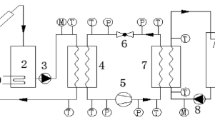Abstract
The favorable heat transfer characteristics of sodium makesit possible to collect concentrated solar radiation at medium high temperatures in small active areas, and therefore, with relatively low losses. However, because of the intermittent nature of the solar source, the receiver and the sodium pump controls must be designed and operated so as to obtain adequate responses to insure receiver structural integrity. The two receivers installed and tested at the site represent two different coolant flow approaches, each of which pose different demands on the control system. This evaluation area reports on studies of this problem situation and in the final analysis, attempts to make clear the necessitity of system integration; that is, the need to design a coolant flow control system specifically for a receiver. This was not the completly true case at SSPS for either receiver. Even with the cavity installation the control was designed for an input power level much higher than was finally realized. The ASR, of course, was required to accommodate the coolant flow/pum** situation that was installed with minimum modification.
The work here described was carried out at ENEL — Automation and Computing Research Center, Cologno Monzese (Milan), Italy by S. Quatela and G. A. Magnani.
SdI designed the ASR direct digital controller.
Access this chapter
Tax calculation will be finalised at checkout
Purchases are for personal use only
Preview
Unable to display preview. Download preview PDF.
Similar content being viewed by others
References
C. Maffezzoni, G. Magnani, and S. Quatela, “Integrated Process and Controller Design of High Temperature Solar Receivers”, Proceedings of the 21st IEEE Control and Decisi3r Conference (CDC), December 1982.
C. Maffezzoni, “The Concept of the Integrated Design of Process, Control, and Operation in Solar Central Receiver Plants”, 2nd International Workshop on the Design, Construction, and Operation of Solar Central Receiver Projects, Varese, Italy, June 1984.
C. Maffezzoni, G. Magnani, and S. Quatela, “Process and Controller Design of High Temperature Solar Receivers”, to appear in IEEE Trans. on Automatic Control, March 1985.
C. Maffezzoni and F. Parigi, “Dynamic Analysis and Control of a Solar Power Plant, Part I: Dynamic Analysis and Operation Criteria”, Solar Energy Vol. 28, No. 2, pp. 105–116, 1982.
C. Maffezzoni and F. Parigi, “Dynamic Analysis and Control of a Solar Power Plant, Part II: Control System Design and Simulation”, Solar Energy Vol. 28, No. 2, pp. 117–128, 1982.
L.A. Gould,“Chemical Process Control: Theory and Applications”, Reading, MA: Addison-Wesley, April 1978.
I.M. Horowitz, “Synthesis of Feedback Systems”, Academic Press, 1963.
V. Bedogni, A. De Benedetti, A. Di Meglio, and C. Sala, “The Almería Advanced Sodium Receiver (ASR): Basic Design and Operating Conditions”, ISES Solar World Congress, Perth (Aus ), August 1983.
V. Bedogni,and A. De Benedetti, “Almeria Advanced Sodium Receiver (ASR): Stress Analysis Considerations”, ISES Solar World Congress, Perth (Aus ), August 1983.
W. Grasse, “IEA - Small Solar Power Systems Project”, International Symposium, Cologne (Ger).
R.W. Mallet, Jr. and R.L. Gervais, “Central Receiver Solar Thermal Power System, Phase 1”, McDonnell Douglas Astr. Co., NTIS rep. n. SAN/1108, Vol. 4, Huntington Beach California, October 1977.
W. McAdams, “Heat Transmission”, Int. Stud. ed. McGraw Hill, 1954.
G.D. Smith, “Numerical Solution of Partial Differential Equation Finite Difference Methods”, Oxford University Press, 1978.
L.A. Gould, “Chemical Process Control: Theory and Applications”, Reading, Mass.: Addison-Wesley, 1969.
I.M. Horowitz, “Synthesis of Feedback Systems”, Academic Press, London, 1963.
C. Maffezoni, G.A. Magnani, and S. Quatela, “Process and Control Design of High Temperature Solar Receivers: An Integrated Approach”, to appear in IEEE-AC Transactions on Automatic Control.
R. Carmona and J.G. Martin, “The SSPS Advanced Sodium Receiver: Transient Response”, IEA/SSPS Deliverable Review, Tabernas (Almería), Spain, October 1984.
Author information
Authors and Affiliations
Editor information
Editors and Affiliations
Rights and permissions
Copyright information
© 1986 Springer-Verlag Berlin Heidelberg
About this chapter
Cite this chapter
Maffezzoni, C., Weyers, H.D., Magnani, G.A., Sánchez, M., Blanco, M. (1986). Systems Aspects/Control. In: Kesselring, P., Selvage, C.S. (eds) The IEA/SSPS Solar Thermal Power Plants — Facts and Figures — Final Report of the International Test and Evaluation Team (ITET). Springer, Berlin, Heidelberg. https://doi.org/10.1007/978-3-642-82678-8_7
Download citation
DOI: https://doi.org/10.1007/978-3-642-82678-8_7
Publisher Name: Springer, Berlin, Heidelberg
Print ISBN: 978-3-540-16146-2
Online ISBN: 978-3-642-82678-8
eBook Packages: Springer Book Archive




